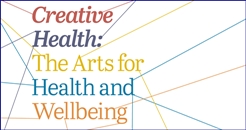 Improving health and wellbeing through the Arts
Improving health and wellbeing through the Arts
From a report by the All-Party Parliamentary Group (APPG) on Arts, Health and Wellbeing
In July 2017, the APPG for Arts, Health and Wellbeing published the results of an Inquiry into 'Creative Health: The Arts for Health and Wellbeing'.
The report summarised evidence on the effect of the Arts on health and wellbeing in various environments e.g. hospitals as well as in stages of life; Childhood, Adolescence and Young Adulthood, Working-Age Adulthood, Older Adulthood and End of Life.
Here are some insights:
-
The heart rate of new-born babies is calmed by the playing of lullabies. The use of live music in neonatal intensive care leads to considerably reduced hospital stays.
-
Visual and performing arts in healthcare environments help to reduce sickness, anxiety and stress.
-
After engaging with the arts, 79% of people in deprived communities in London ate more healthily, 77% engaged in more physical activity, 82% enjoyed greater wellbeing.
-
Music therapy reduces agitation and need for medication in 67% of people with dementia.
-
Arts therapies help people to recover from brain injury and diminish the physical and emotional suffering of cancer patients and the side effects of their treatment.
-
Attendance at concert halls, galleries, heritage sites, libraries, museums and theatres, reduces work-related stress and leads to longer, happier lives.
-
An arts-on-prescription project has shown a 37% drop in GP consultation rates and a 27% reduction in hospital admissions.
-
Arts therapies have been found to alleviate anxiety, depression and stress while increasing resilience and wellbeing.
There are numerous case studies. Here are three:
Artlift Arts-on-Prescription Scheme, Gloucestershire is a primary care-based scheme set up by a GP in response to frequent visits by patients experiencing depression and anxiety. It is now operated across nine surgeries and community spaces in Gloucestershire and five pilots in Wiltshire, with reach into deprived areas. Health professionals refer patients with a wide range of conditions – from depression and anxiety to chronic pain to stroke – to take part in an eight-week course of two-hour sessions, led by a professional artist working in poetry, ceramics, drawing, mosaic or painting. Participants are encouraged to pursue their own creativity in a studio-like, rather than medical, environment. Artists have regular training in clinical supervision and safeguarding, to ensure they are able to identify cases where patients need to be referred back to their clinician. The goal of the programme is to encourage and assist the self-management of long-term conditions in the community.
Russell, who was referred to Artlift with physical and mental health problems after suffering a serious stroke, attended for six months. He began painting expressionistic portraits of people who interested him, which helped to rid him of anxiety and stress. He no longer takes anti-depressants and, although his depression has not completely gone, Russell describes how he locks himself away and paints until he feels better. He has had several exhibitions and now mentors others at Artlift.
An evaluation found a significant improvement in wellbeing, improved mood and enjoyment of creative activity. In the year after starting the course, GP consultation rates dropped by 37 percent and hospital admissions by 27 percent. Many participants have been inspired to continue pursuing their creative practice, either at home or by setting up new groups.
Sistema Scotland: Big Noise and Sistema England: In Harmony. These projects work on the basis that ‘children from disadvantaged backgrounds can gain significant social benefits by playing in a symphony orchestra’. It draws on a model established in Venezuela, offering an immersive orchestral programme to pre-school and school-age children and young people. Neither an audition process nor a fee is necessary to participate, and efforts are made to involve children with complex needs in areas of low arts engagement. Excellence is pursued, with teaching provided by professional musicians and highly skilled and motivated participants being sought for public performances. Evaluation shows potential for improvements in health and wellbeing via seven pathways: engagement with learning; life skills; emotional wellbeing; social skills and networks; respite and protection; musicianship; healthy behaviours. There was a substantial net gain in social value, realised within six years of the programme beginning and increasing over the lifetime of participants.
Silver Song Clubs. The charity Sing for Your Life offers 90 minute participatory music activities to older people in community centres, care homes, etc. Community singing takes place in its Silver Song Clubs, promoting healthy ageing under the slogan ‘a song a day keeps the doctor away’. In 2012, research was conducted to explore the effects of community singing. Five new singing groups were set up in East Kent, and volunteers aged over 60 were randomly assigned to one of these groups or to a non-singing group. Participants in the singing groups took part in a 12-week programme led by Sing for Your Life. Compared to the control group, three months into the project the singers reported significantly improved quality of life and lower anxiety and depression; after six months, these benefits had diminished but still exceeded those measured at the outset. Singing involves focused attention and controlled breathing, which counteracted anxiety and stress; offers social support, helping to overcome isolation and loneliness; promots learning as an antidote to cognitive decline; provides a regular commitment that discourages inactivity; raises the spirits and makes people happy.
Download the report from here.
Why not review the gifts for arts in your church and think how they could be used for outreach? Not only for outreach but also to affect the health and wellbeing of those in the community?
Retweet about this article:
From a report by the APPG on Arts, Health and Well, 22/08/2017